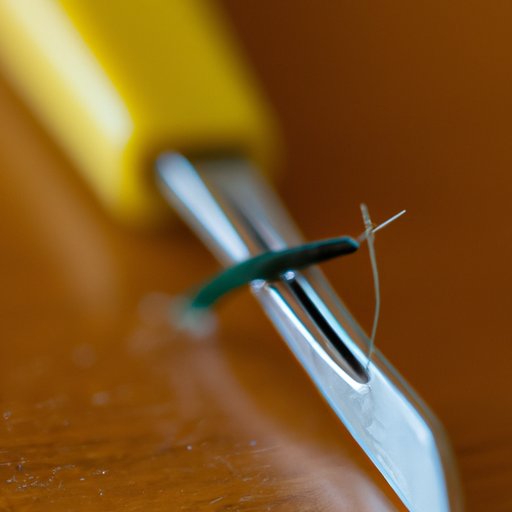Introduction
As a dog owner, it is important to know how to properly remove ticks from your dog. Ticks are tiny arachnids that can attach themselves to your dog’s skin and feed on their blood. If left untreated, ticks can cause serious health problems for your furry friend. This article will provide you with a step-by-step guide on how to safely remove ticks from your dog’s body, as well as tips on preventing tick bites and addressing common misconceptions about tick removal.
Identifying and Removing Ticks
The first step in removing a tick from your dog is to identify the tick’s location on their body. Ticks are typically found in warm and damp areas on your dog’s body, such as their armpits, groin, or behind their ears.
To remove the tick, it is recommended that you use a single-pointed tweezer or a tick removal tool. Grasp the tick by the head as close to the skin as possible, being careful not to squeeze the tick’s body. Pull the tick straight out of your dog’s skin in a straight and steady motion. Do not twist or jerk the tick as this could break off the mouthparts and increase the chance of infection.
It is essential to ensure that the whole tick has been removed from your dog’s skin. If you accidentally leave any parts of the tick behind, this can cause an infection. Check to make sure that all the parts of the tick, including the head and legs, have been removed.
Tools Required for Tick Removal
There are various tools that you can use to remove ticks from your dog’s skin. The most commonly used tools are tweezers and tick removal tools. Tweezers provide a fast and easy way to remove ticks, and most households already have a pair of tweezers on hand. Tick removal tools are specifically designed to remove ticks without squeezing them, which can reduce the chance of infection.
When using tweezers, ensure that they are pointed and not blunt. Blunt tweezers may not be able to grip the tick’s head, which could cause the tick to be left behind. Tick removal tools have a specialized fork-like design which can effectively grip the tick’s head without squeezing its body.
Preventing Tick Bites
Preventing tick bites is an important aspect of tick control. The best way to prevent ticks from biting your dog is to avoid areas with high tick populations. Ticks are typically found in wooded areas, tall grasses, and areas with lots of animals, such as local parks.
Another way to prevent tick bites is to use tick repellent products. These products contain active ingredients that help to ward off ticks and prevent them from biting your dog. Make sure to choose a product that is specifically formulated for dogs, as some products for humans can be toxic to dogs.
Lastly, the most effective way to prevent tick bites is to regularly check your dog’s skin for ticks. This will allow you to remove ticks quickly before they have time to attach themselves and feed on your dog’s blood. If you find a tick, use the steps outlined earlier to remove it safely.
Risks Associated with Tick Bites
Leaving ticks attached to your dog can put them at risk of contracting tick-borne illnesses, such as Lyme disease. Lyme disease is caused by a bacterium that is transmitted to dogs and humans through tick bites. Symptoms of Lyme disease in dogs include a loss of appetite, fever, lethargy, and lameness.
If you suspect that your dog has been bitten by a tick and develops any of these symptoms, seek veterinary care immediately. Early diagnosis and treatment of Lyme disease can help to prevent serious health problems for your furry friend in the long run.
Common Misconceptions About Tick Removal
There are many common misconceptions about tick removal that can be harmful to your dog. Some people believe that using alcohol, petroleum jelly, or a lit match to remove a tick is effective, but these methods can actually make things worse. Alcohol and petroleum jelly can cause the tick to release more toxins into your dog’s skin, while a lit match can increase the risk of burning your dog.
The safest and most effective way to remove ticks from your dog is to use a single-pointed tweezer or a tick removal tool, as mentioned earlier.
Products to Use After Tick Removal
After you have successfully removed a tick from your dog, it is recommended that you use products to help prevent future tick bites. One popular option is a tick collar, which releases a tick-fighting ingredient that repels ticks for several months. Another option is the use of a spot-on treatment, which is applied to your dog’s skin and slowly releases tick-fighting ingredients into their system over several weeks.
Consult with your veterinarian to determine which products are best for your dog’s specific needs and lifestyle.
Conclusion
In conclusion, being able to properly remove ticks from your dog is an essential part of being a responsible dog owner. Always check your dog’s skin for ticks, and if you do find one, use the proper tools and techniques to remove it safely. Preventing tick bites is also an important aspect of tick control, and there are various products available to help protect your dog from ticks. Don’t hesitate to seek veterinary care if your dog develops symptoms after being bitten by a tick.
